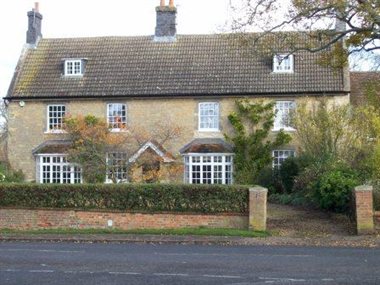Chellington House
This article was written by Pamela Hider

Chellington House, early 1930s (courtesy Carlton & Chellington Historical Society)
This Grade II listed house, believed to date from 1670, is described by The Historic Environment Record for Bedfordshire as follows:
C17 house remodelled in C19. Coursed limestone rubble. C20 concrete tile roof. Stone gable coping. Two storeys and attics. Off-centre double brick ridge stack in line with front door. Two gable red brick stacks. Two attic box dormers. First floor has four C19 sash windows with glazing bars. Ground floor: one canted bay window, one sash window with glazing bars, gabled porch with scalloped bargeboards and doorway with cambered arch, one canted bay window, one sash window with glazing bars, and a single light casement with glazing bars under a timber lintel.
Chellington House stands at the junction of Bridgend (aka Bridge End) with The Moor. In archive documents its address was No.1 Bridgend, but since 1991, this address has been taken by a new dwelling (see below). Its former name was "The Yews" and our earliest record with this name is the census of 1881 which showed John Fairey, farmer, as the owner living here with his wife and child and one servant. By 1890 an Albert Horton was in occupation (Kelly's Directory) and by 1894 the Misses Hilton were living there (ibid). Susanna & Harriet Hilton were described in Kelly's directory of 1898 as Principal Landowners in Pavenham although they continued to live at The Yews in Chellington until 1902 (Electoral Rolls). They probably moved to Pavenham shortly after this time as they both died there (Susanna in 1913 and Harriet in 1923) and are buried in Pavenham churchyard.
Reverend Edwin Gorsuch Gange
From 1903-1921 (Kelly's Directories), the occupant was a Baptist Minister, the Rev. Edwin Gorsuch Gange. He was born in 1844 and had been Minister at the Broadmead Baptist Church in Bristol for 24 years. Two memorials windows in his memory were placed there by his distinguished son, Edwin Stanley Gange, M.P., J.P., a deacon of that church. The Rev. Edwin was not active in Ministry whilst in Chellington, and had probably retired here, where he died in 1921. His name appears as occupant in the Valuation Records of 1910 (DBV/1/25) but the owner of The Yews in 1910 was still John Fairey (who died in 1913).
By 1924, the unmarried William Reginald Battams (who had lived with his parents at Stayesmore Manor House, Carlton) was in occupation. He died in 1925, which marked the end of the Battams era in Carlton.
1926
Under the Rating and Valuation Act 1925 (DV1/C227), every piece of land and building in the country had to be valued to determine the rates to be paid upon it. This was done in Chellington in 1926, and from it we learn that the owner was William Fairey, the elder of the two sons of John Fairey, who had died in 1913. It is likely then that William had been the owner since 1913. William, originally from Harrold, farmed a large acreage in the locality of Carlton and Harrold and moved with his family to Stayesmore in the 1920s where they were occupants, the owner being Bedford County Council.
The occupant at The Yews was H.Franklin and the house was described as follows:
Stone & tiled; 2 Reception Rooms, Kitchen, W.C. Upstairs were 3 bedrooms, Bathroom and on the Second Floor were 3 small attics. Outside were a coal cellar, garage, 2 loose boxes (not used), loose box and coach house and also a conservatory. The property had electric light . Two comments were recorded - "V.nice, stands back" and "Lovely old place". Not in the Evaluator's remit, but of interest, is that Chellington House retains a 17th century well and that the hand pump next to the well (present but no longer working) was still working into the early 20th century (information from present and previous occupants). Perhaps surprisingly, the property was described as semi-detached. Although indeed there is another dwelling attached, to the south, which is smaller, structural evidence suggests it to have originally been an extension to The Yews. This second dwelling is known as The Den (No.3 Bridgend).
Outbuildings to the north have also been converted to a separate dwelling and described by HER as "A post medieval barn, it is a stone construction with a slate roof. There is at least 1 stone buttress to the front elevation. By 1991 the barn had been converted into a residential dwelling". This third dwelling is known today as Bridgend Barn and has become the new No.1 Bridgend (former address of Chellington House). Thus Chellington House, the capital building, remains between No.1 & No.3, by name. A passer-by might have no notion that all three buildings were once part of the same farming estate.
1928 is the first time the name "Chellington House" appears in our records (Kelly's Directory), when a Captain Franklin lived there. A Mrs. Harper lived there in 1931 (ibid) and a Charles Milton in 1936 (ibid). The electoral rolls of 1936 saw the New family living there.
By the time of the electoral rolls of 1938, William Fairey had moved from Stayesmore Manor House into Chellington House, of which he was the owner , and his family were to be in occupation for more than thirty years. After this time, the house was much altered internally by its next occupant, an architect. Since then, the family of Paul Wells (of the Wells Brewers' family) occupied the House, followed by a family in 2006 who remain the occupants today.

Chellington House, November 2019